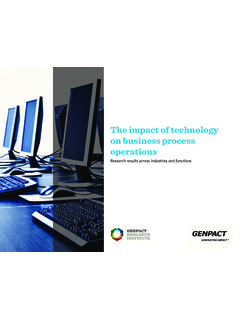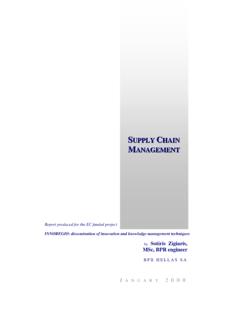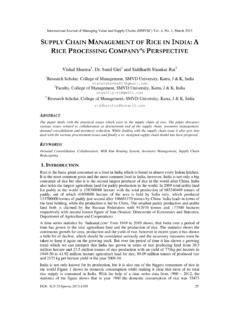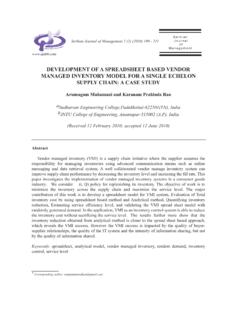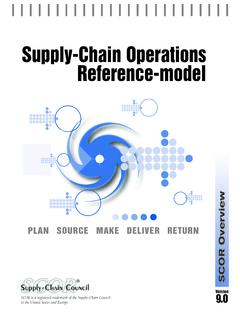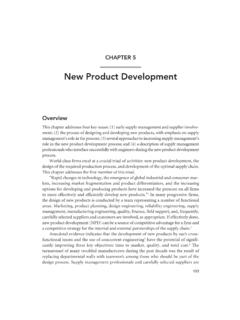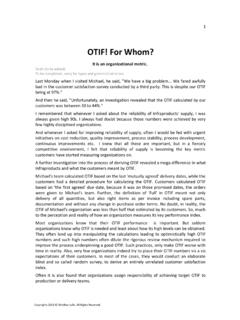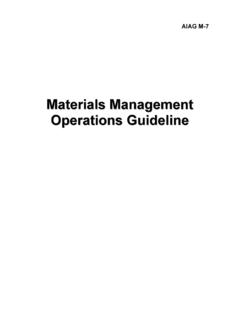Transcription of GenerAtinG SUPPLY CHAin iMPACt - genpact.com
1 DESIGN TRANSFORM RUND riving SUPPLY CHAin excellence through Data-to-Action AnalyticsSMGenerAtinG SUPPLY CHAin iMPACtSupply CHAin excellence is a powerful competitive advantage in a global marketplace. Thousands of miles away from customers, hundreds of turbulent events create volatility in SUPPLY markets, which affect material and service availability and costs. Creating strategic advantage amid these volatile environments requires real-time insights from operational data to improve performance visibility and global web of manufacturing and logistics teams can be stalled by delayed shipments, inefficient plants, and inconsistent suppliers, among other things.
2 This can be costly, frustrating, time-consuming, and, under certain circumstances, even risky. Multiple studies show that the most significant challenges for SUPPLY CHAin executives today involve the following: Providing visibility into SUPPLY CHAin performance and bench-marking Reducing operating costs through process optimization across the plan, source, make, and deliver functions Enhancing customer satisfaction by improving SUPPLY CHAin responsiveness and product qualityIn the 2014 Chief SUPPLY CHAin Officer (CSCO) survey conducted by SCM World, 65% of respondents (n=1,100) indicated big data analytics in the SUPPLY CHAin was the most disruptive and important trend in SUPPLY CHAin strategy.
3 The importance of volatile demand as a concern in 2014 coupled with the hope that better visibility may come from drilling into huge new data sources makes big data a big 2014 study by Markets and Markets projected that the SUPPLY CHAin analytics market would grow from $ billion in 2014 to $ billion by 2019, at a compound annual growth rate (CAGR) of during the forecast period, indicating the growing focus for organizations to embed intelligence in their SUPPLY CHAin processes, and the evolution of the SUPPLY CHAin from a tactical lever to a strategic transformation insights derived from embedding analytics in the SUPPLY CHAin are helping companies optimize their SUPPLY CHAin functions and close the gaps to manage market pressures and contribute to financial , we hypothesize, validated by thousands of client interactions.
4 That without a new process architecture reimagined in the context of analytics and technology and supported by an advanced organizational model, business leaders will continue to be frustrated at making only incremental gains with their technology investments, especially when it comes to analytics, in a world where companies are looking for significant improvements in revenue, productivity, and competitiveness from incremental visibility driver: Moving towards a smarter SUPPLY chainGlobalization has created an explosion in the number and types of suppliers, manufacturing units, and distribution locations.
5 While the business growth opportunities are convincingly strong, growing product variance tailored to globally dispersed customers has created a complex web of regional SUPPLY chains that must be closely and carefully s recent CSCO profile survey suggests organizations are looking to improve visibility into their SUPPLY CHAin , beyond the organization and into the supplier and customer SUPPLY CHAin efficiency begins with enhancing basic metrics and reporting, as they provide the essential data for performance improvement initiatives and end-to-end visibility of their extended SUPPLY chains.
6 However, irreversible globalization is making it necessary to go beyond the basics to achieve maximum iMPACt . Advanced analytics-driven control towers can monitor real-time critical events and KPIs through multiple touch points. When combined with predictive analytics, control towers can provide valuable savings in areas such as freight optimization for the customer; a centralized KYC would contribute in a big way. Organizations that are knowingly investing in visibility can make decisions to increase SUPPLY CHAin responsiveness, optimize cost, and minimize customer volatility driver: rethinking demand and inventory managementDemand volatility has increased significantly and permanently, making demand and inventory management a challenge.
7 Poor forecast accuracy continues to plague organizations, and traditional demand management practices are no longer enough to guarantee industries, such as consumer goods, retail, automotive, and logistics, require daily or even real-time forecast regenerations to perform at market. For the pharmaceutical and healthcare industries, however, there are additional important quality and human health implications when considering demand and inventory management. Life-enhancing drugs must be readily available. There can be zero tolerance for bottleneck manufacturing when demand is high.
8 Counterfeit and grey market drugs also must be kept in check through increased visibility, especially during a period when regulatory controls have increased and customers are more empowered in making choices. Investing in production- and SUPPLY CHAin related operational controls and balanced sourcing is way overdue in these industries and others. There is an immediate need to have key inventory and forecasting metrics more visible and to optimize replenishment analytics can be applied to these areas to more accurately anticipate demand, predict and monitor SUPPLY and replenishment policies, and plan inventory flow of goods and services.
9 The latter is especially relevant for customer-focused organizations, allowing them to leverage their historic data sources to optimize service levels, augment investment decisions, and improve supplier performance and quality controls. Companies will also be able to run simulations on best-fit solutions, program contextual exception-handling alerts, and use multi-criteria inventory ranking with the assistance of advanced and inventory management is arguably the most important challenge in achieving global SUPPLY CHAin flexibility.
10 Winning organizations will proactively exploit their data cost driver: Optimizing sourcing and logistics activitiesSupply CHAin leaders face spiraling costs across the board. These costs significantly iMPACt key financial metrics, such as working capital, cost of goods sold, and cash flow. Especially in industries with large inventories of raw or finished goods, there is a constant need to improve financial pharmaceutical providers have concluded that operations and SUPPLY CHAin management are best outsourced to contract manufacturing providers.



